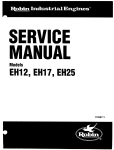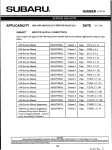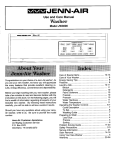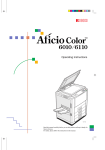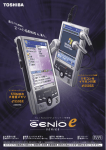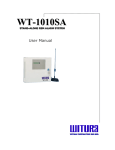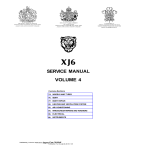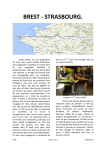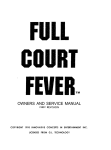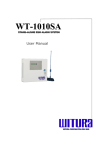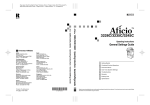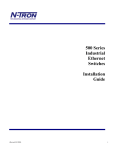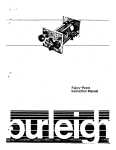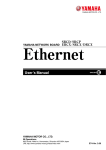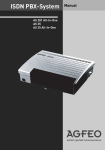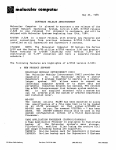Download Fitel S175 User Manual
Transcript
FTS-8062-5 §I 75 version2000 SINGLE-FIBER FUSION SPLICER User’s Manual Please read entire manual prior to usage. This manual must be kept with the S175 Fusion Splicer. Issue 5. April 2000 4 T H E FURUKRWA €L€CTRIC CO., Contents 1. Safety Information and Instructions 1.l. Safety Information 1.2. Safety Messages 1.3. WARNINGS and CAUTIONS 1.4. Power Requirements 1.5. Fuses 1.6. Line Power Cord 1.7. Toxic Hazards 1.7.1. Incineration 1.7.2. Acidic or caustic compounds 1.7.3. Physical damage 2. General Information 3. Operating Specifications and Components 3.1. 3.2. 3.3. 3.4. 4. Specifications Components Optional Accessories Recommended Consumable External Description 4.1. Operating Keys and Status LEDs 4.2. Side Panel 4.2.1. Right side panel 4.2.2. Left side panel 4.3. Main Body 5. Getting Started 5.1. 5.2. 5.3. 5.4. 5.5. 6. Unpacking and Initial Inspection Setup Installing the splice programs Selecting the Operating Language Arc check Operating Instructions 6.1. Ready Screen 6.2. Fusion Splicing 6.2.1. Preparing the Fiber 6.2.2. Loading the Fiber 6.2.3. Fusion Splicing 6.2.4. Splicing Defects 6.2.5. Removing the Spliced 6.2.6. Reinforcing the Fusion Splice 6.2.7. Changing the Fusion Program 6.2.8. Changing the Heater Program 6.2.9. Performing an Attenuation Splice (Optional) 7. Maintenance and Handling Instructions 7.1. Error Messages 7.2. Maintenance 7.2.1. Arc Check 7.2.2. Electrode Maintenance 7.2.3. Cleaning the objective lens 1 1 1 2 5 5 5 5 5 6 6 7 11 11 12 13 13 14 14 15 15 15 16 17 17 17 18 20 21 23 23 23 23 24 25 27 27 28 29 30 31 32 32 35 35 35 36 Contents 7.2.4. 7.2.5. 7.2.6. 7.3. 7.4. 7.5. Cleaning the Mirrors Cleaning the V-grooves Cleaning the V-groove Fiber Clamps Storing and Shipping Claims and Repackaging Return Shipments to The Furukawa Electric Co. 8. Programming Guide 8.1. Programming Functions and Menu 8.2. Modifying a Fiber Program 8.3. Modifying a Heater Program 8.4. Splice Data 8.4.1. 8.4.2. 8.4.3. 8.4.4. 8.5. 8.6. Arc Check History Configuration 37 38 38 38 39 39 41 45 48 48 49 49 51 52 52 52 52 53 Environment Monitor Manual Operation Rust Check Motor Limit Test Fiber Dimension Program Management 56 56 57 57 58 61 8.12.1, 8.12.2. 8.12.3. 8.13. 37 Language Arc Counter Total Arc Counter Sleep Time LCD Data Output Low Temp. Motor Rate Low Temperature TENSION TEST Estimation Loss Arc Count Reset 8.6.1. 8.6.2. 8.6.3. 8.6.4. 8.6.5. 8.6.6. 8.6.7. 8.6.8. 8.6.9. 8.6.10. 8.7. 8.8. 8.9. 8.1 0. 8.1 1. 8.12. Viewing the data Adding a Comment Printing the Data Clearing the data 37 Program Store/ Default PROGRAM COPY PROGRAM DELETE Adjust Raterime 53 53 53 54 54 54 54 61 63 64 64 Safety Information and Instructions This manual contains complete operating and maintenance instructions for THE S175 FUSION SPLICER. Please review this manual carefully before operating. 1.l. Safetv Information The following safety instructions must be observed whenever the S175 fusion splicer is operated, serviced or repaired. Failure to comply with any of these instructions or with any precaution or warning contained in the User’s Manual is in direct violation of the standards of design, manufacture and intended use of the instrument. The Furukawa Electric Co., Ltd. assumes no liability for the customer’s failure to comply with these safety requirements. 1.2. Safety Messages A 1 Refer to the User’s Manual for instructions on handling and operating the instrument safely. WARNING The procedure can result in serious injury or loss of life if not carried out in proper compliance with all safety instructions. Ensure that all conditions necessary for safe handling and operation are met before proceeding. CAUTION The procedure can result in serious damage to or destruction of the instrument if not carried out in compliance with all instructions for proper use. Ensure that all conditions necessary for safe handling and operation are met before proceeding. 0 Please contact The Furukawa Electric Co., Ltd. or your local representative with any questions relating to any subjects described within this manual. 0 In no case will The Furukawa Electric Co., Ltd. be liable to the buyer, or to any third parties, for any consequential or indirect damage which is caused by product failure, malfunction, or any other problem. 1 Safety Information and Instructions 1.3. WARNINGS and CAUTIONS WARNI 0 This is a Class A product of EN 55022(1994). In a domestic environment this product may cause radio interference in which case the user may be required to take adequate measures. 0 The power cord supplied with this equipment must be connected to a power socket, which provides a reliable protective earth. Or, ground it with the Ground terminal on the fusion splicer. 0 Use only the cords attached to the fusion splicer. Connecting inappropriate cords or extending the cords may cause them to heat up abnormally and may cause fire. 0 This product contains a Lithium Cell. The device is identified by a warning label. Do not dispose of in fire. Disposal of this device must be carried out by qualified personnel. 0 Never touch the electrodes when the fusion splicer is powered on. Doing so may cause electrical shock. ~~ ~ Do not operate the fusion splicer without electrodes. 0 Do not disassemble the instrument except as described in the maintenance section of this manual. The fusion splicer contains no user serviceable parts. Warranty on this product will be invalidated if any of the potted nuts are disturbed. 0 Avoid soaking the fusion splicer with water. Doing so may cause fire, electrical shock or malfunction. 0 Do not use inappropriate input voltage. Doing so may cause fire, electrical shock or malfunction. 0 Do not insert or drop any metal or any flammable material into the main body through any aperture. Doing so may cause fire, electrical shock or malfunction. 0 Avoid direct skin contact with the heating portion. This may cause burn or injury. 0 Do not remove the panels of the fusion splicer. Some parts generate high voltage. Removing the panels may cause electrical shock. ~~ ~~ ~ 0 If abnormal sounds or extra high temperatures are observed, turn off the power, disconnect the power cord and contact The Furukawa Electric Co., Ltd. or your local representative. Continuing to operate under these conditions may cause fire or electrical shock. 0 Do not use a damaged power cord where the inner cable is exposed or severed. Doing so may cause fire or electrical shock. 2 Safety Information and Instructions 0 If water is spilled into the fusion splicer, turn off the power switch, disconnect the power cord and contact The Furukawa Electric Co., Ltd. or your local representative. Continuing to operate under these conditions may cause fire or electrical shock. 0 If smoke or strange smells are observed, turn off the power switch, disconnect the power cord and contact The Furukawa Electric Co., Ltd. or your local representative. Continuing to operate under these conditions may cause fire, electrical shock or malfunction. 0 If the fusion splicer is dropped and damaged, turn off the power switch, disconnect the power cable and contact The Furukawa Electric Co., Ltd. or your local representative. Continuing to operate may cause fire or electrical shock. 3 Safety Information and Instructions I 0 Do not place the fusion splicer on an unstable or inclined surface. There is a possibility that the fusion splicer will fall and cause injury. 0 Disconnect all cords when moving the fusion splicer. Failure to do so may damage the cords which may cause fire or electrical shock. 0 Do not place the cords around any heating instrument. Doing so may damage the cords which cause fire or electrical shock. 0 Do not connect or disconnect cords with wet hands. Doing so may cause fire or electrical shock. 0 Do not pull the cord to disconnect. Doing so may damage the cords which may cause fire or electrical shock. Hold the plug portion and disconnect the cord. 0 Do not put heavy items on the cords. Doing so may damage the cords which may cause fire or electrical shock. 0 Do not modify the cords and do not over-bend, over-twist, or over-stretch the cords. Doing so may cause fire or electrical shock. _ _ ~ ~ 0 Ensure that the cords are disconnected when storing the fusion splicer. 0 Never use aerosol dust cleaners or alcohol-based solvents to clean the electrodes. 0 Non oil-based solvents should be used to clean the optical lenses. 0 Store the fusion splicer in a cool dry place. 4 Safety Information and Instructions 1.4. Power Requirements The S175 fusion splicer can operate from any single-phase AC power source that supplies between 100-120 V and 200-240 V at a frequency of 50 Hz to 60 Hz , or from DC 10-16 V. 1.5. Fuses Use only the correct size of 250 VAC fuse as specified in this manual. 1.6. Line Power Cord The S175 uses a three-wire power cord equipped with a protective earth contact. Do not connect an extension cord that does not have this feature. When connected to an appropriate AC power source, the power cord grounds the instrument chassis. To avoid the risk of injury or death, ALWAYS observethe A WARNING following precautions before initializing the S175 fusion splicer. Do not connect both AC and DC power sources at the same time. Connect one source or the other. If using a voltage-reducing autetransformer to power the S175 fusion splicer, ensure that the common terminal connects to the earthed pole of the power source. Use only the type of power cord supplied with the S175 fusion splicer. Connect the power cord only to a power outlet equipped with a protective earth contact. Never connect to an extension cord that is not equipped with this feature. Willfully interruptingthe protective earth connection is prohibited. 1.7. Toxic Hazards Under normal conditions of use, storage, and handling the S175 fusion splicer presents no toxic hazards. However, under the following conditions, certain precautions are necessary. 1.7.1. Incineration Some of the electronic components included in the assembly are constructed with resins and other chemicals that produce toxic fumes during incineration. 5 Safetv Information and Instructions 1.7.2. Acidic or caustic compounds Some of the electronic components included in the assembly, particularly electrolytic capacitors, contain acidic or caustic compounds. In the event that a damaged component comes in contact with the skin, wash the affected area immediately with cold water. In the event of eye contamination, irrigate thoroughly with a recognized eye-wash and seek medical assistance. 1J.3. Physical damage Some of the components used in the assembly may contain very small quantities of toxic materials. There is a remote possibility that physically damaged electronic components may present a toxic hazard. As a general precaution, avoid unnecessary contact with damaged electronic components, and arrange for disposal in accordance with local regulations. 6 General Information Fusion splicing is used to physically join together two optical fiber ends; the process may vary, depending on the type of fusion splicer used. The S175 Single-Fiber Fusion Splicer has an active core aligning mechanism to align the fiber ends and a controllable electric arc to melt the glass and butt the ends together. This results in a strong joint, with very low loss and very low back-reflection. To achieve good splicing results, it is essential to know both the proper use of a fusion splicer and the characteristics of optical fiber. Because not all fibers are identical, they can melt or fuse at different temperatures. Therefore, to minimize splice loss, it is important that the arc power and the duration of the fusion arc be properly adjusted. The S175 fusion splicer features an inspection of arc function to help the user adjust these parameters. Other intrinsic factors that contribute to the increase in splice loss are core diameter mismatch, cladding diameter mismatch, numerical aperture mismatch, core concentricity and noncircularity. Core Diameter Mismatch Cladding Diameter Mismatch Numerical Aperture Mismatch Different fibers have different numerical apertures. The aperture dictates the acceptance angle of light. 7 General Information Core Concentricity Core Noncircularity - core2 core1 Optical fiber is basically classified as either single-mode (SM) or multi -mode (MM). Single-mode fiber, which includes dispersion-shifted fiber types, will transmit a singlemode (path) of data at wavelengths greater than the cut-off wavelength (1 170 nm). Approximately 80% of the light is transmitted within the core, and 20% is transmitted in the surrounding cladding. Therefore, the transmission path is more accurately referred to as the mode field and not as the core. With a core diameter of typically 8 pm and a mode field diameter of approximately 10 pm, single-mode fiber can transmit more data than multi-mode fiber and with less attenuation. In multi-mode fiber, the optical signal is transmitted entirely within the core. These fibers have a core size of 50 pm to 100 pm (50 pm or 62.5 pm, typically) and are commonly used in local area networks (LANs), short distance links and closed circuit television (CCn/)- Physical Characteristics of Optical Fiber for Fusion Splicing Coating standard diameter material 250 pm, 900 pm acrylic resin, nylon Cladding standard diameter material 125 pm silica, Fluoro doped Titan-coated silica Core standard diameter material I silica, 8 pm - 10 pm (SM) 50 pm - 62.5 pm (MM) Germanium doped silica, silica a I Dispersionshifted Single-mode Multimode superior high low high middle very low difficult middle easy Transmitting capacity Splice loss Splicing ease Physical Characteristics of Single-mode and Multimode Fiber 50/125 Multimode 62.51125 Multimode 125 pm 125 pm corm tran;mits light dadding keeps opbcal signal within core Singlemode 100/140 Multirnode 1 140 pm coating protects glass from abrasion and ensures high strength r-T> typical diameter of human hair 9 General Information ~~~~~~ ~~ ~ Core Diameter/Axis offset Because the optical signal is transmitted through the core of the fiber, it is important to understand how the cores of the two fibers being spliced together compare. The following general formula can be used to show the effects of core offset on the splice loss. The formula is only theoretical and does not take into account other extrinsic factors such as cleave quality and dust contamination, and intrinsic factors such as core noncircularity and numerical aperture. mode field diameter B[vm] mode field diameter Npm] core axis offset d[pm] I optical power OUTPUT optical power INPUT ____, left fiber \ right fiber L splice loss splice loss = Io x log,, OUTPUT = Io x INPUT [(A’2AB+ B‘ EXP(- 2d’ A‘ + B’ )] A difference between A and B will cause a splice loss, even if d is zero. If using single-mode fiber, the manufacturer of the fiber may be able to provide mode field diameter specifications. is impossible to have perfectly centered cores, because fiber manufacturing limitations often result in small offsets. Today’s optical fibers are well manufactured and have core eccentricity of less than 0.5pm. However, older fiber exhibits core eccentricity near 1.Opm. The S175 fusion splicer, which has an active core alignment function by observing the core position with microscope and image processor, aligns the cores of both fibers to minimize the axis offset described above. Operating Specifications and Components 3.1. Specifications ~ Minimum Fiber cladding diameter 100 I Coated fiber range ~~ Typical ~ Maximum ~ _ _ _ _ ~ Units 150 - 250,900 Fiber strip length 10 (1Omm is optional for 900 pm coating) 16 mm 0.02 0.01 0.04 dB dB dB Average splice loss (Identical fibers) Single-mode Multi-mode Dispersion shifted Environmental Operating temperature Storage temperature Humidity (Non condensing) -10 -40 50 60 95 "C "C %R.H. Electrical Input terminals from AC supply 10 100-120 200-240 12 16 VDC 27 70 Watt VAC Dimensions Splicer Carrying case 181Wx 285D x 181H 470W x 291D x 420H mm mm Weight Splicer Carrying case 6.3 4.8 Data storage Splice Data Arc Check History 400 100 Program storage Fusion Program Heater Program splices checks 32 Q U Typical Splice time 19 (Accurate Estimation Mode) 17 (High Speed Mode) see Typical Reinforcing time 75 (with S922) / 90 (with S921) sec 11 Operating Specifications and Components 3.2. ComDonents Part Part Number Quantity Top cover S175X-02 I I Work table S175X-03 I AC Power cord S175X-04 1 Spare electrode S175X-05 1 pair Spare fuse S175X-06 1 pair Carrying case S175X-07 1 DC Connector S175X-08 1 S175X-01 Main body ~ I User's manual I 1 1 1 1 DC power cord S 175X-A01 1 RS-232C cord S 175X-A02 1 Battery S 175X-A04 1 b Operating Specifications and Components 3.3. Optional Accessories Contact The Furukawa Electric Co., Ltd. or your local representativefor a more detailed specification. S210 stripper S321 precision cleaver S322TR precision cleaver for Titan fiber S323 precision cleaver S423 Tool kit (including S210 and S321) S901 high-capacity battery S902 printer S921 60mm length splice protection sleeves S922 40mm length splice protection sleeves 3.4. Recommended Consumable Keep a supply of the following items with the S175 fusion splicer at all times. Spare electrodes (Part No. S175X-05) Fuse (Part No. S 175X-06) Tweezers Protective eye glasses Electrode cleaning block Denatured alcohol Lint-free tissues or swabs Container for disposal of scrap fiber 13 External Description 4.1. Operating Keys and Status LEDs I Kevs Function Initiates, pauses and resumes the fusion splicing cycle. Escapes an operation, and returns to the orevious menu. I (LED) I (Volume) I 'OWE' 1 Changes the parameter value. Initiates an arc for fusion splicing and an additional arc. Changes the parameter value. Indicates power condition. (See below) Brightness control for LCD Monitor. - POWER LED indicates the power conditions as below. ~~~ LED color Red 1 Orange I Green I ~ Power condition with Power condition with AC input Inappropriatevoltage (4OV or 17.5Vc) Lower voltage Inappropriatevoltage (c85V or 2 6 5 k ) ( 1 0 - 1 1\A Appropriate voltage 14 Appropriate voltage External Description 4.2. 4.2.1. .2. Side Panel Right side panel Left side panel Description Label SERIAL PORT VIDEO RS-232C interface for data communication PIN connector for video output 15 External Description 4.3. Main Body LC;D Mor - Pin fa Front Side Electrode Fiber Holder Rear Side Electrode V Groove Fiber Clamp 16 Gettina Started 5.1. UnDackina and Initial InsDection 1. Inspect the shipping container for any indication of excessive shock to the contents. 2. Remove the S175 carrying case from the shipping container, and open the case. Ensure that the carrying case is right side up before opening. 3. Inspect the contents to ensure that the shipment is complete. 4. Lift the S175 fusion splicer out of the carrying case by its carrying handle, and place the instrument on a flat, smooth surface. 5. Visually inspect the S175 fusion splicer and all accompanying components for structural damage that may have occurred during shipping. Immediately inform The Furukawa Electric and, if necessary the carrier, if the contents of the shipment are incomplete, if any of the S175 fusion splicer components are damaged or defective, or if the S175 fusion splicer does not pass the initial inspection. I A To avoid electrical shock, do not initialize or operate the S175 fusion splicer if it bears any sign of damage to any portion of its WARNING exterior surface, such as the outer cover or panels. 5.2. I Setup 1. Lift the S175 fusion splicer out of the carrying case by its carrying handle, and place the instrument on a flat, smooth surface. 2. If necessary, insert the holes of the work table onto the pins at the front side of the splicer, then lower the work table to lock it. 3. Make sure that the power switch of the S175 is turned off and connect the power cord properly to the power source. 4. Set the power switch to AC or DC in accordance with the power source connected, and the "FITEL" logo is displayed. 17 Getting Started 5.3. Installing the splice programs Install the splice programs with the "Install Program" screen, which appears after the "FITEL" logo. 1. Press A or V to scroll to the Fusion Programs and press + or - to the Heater Programs. or J to decide the selection. 2. 3. "SYSTEM RESET" is displayed on the LCD monitor and the machine returns to the initial condition for starting operation. 4. "READY" is displayed on the LCD monitor with a beep when the reset operation is complete. The S175 fusion splicer is shipped with the following factory-set programs. Those factory-set programs are as followings. Fusion programs AUTO The S175 fusion splicer automatically installs an appropriate fusion program from the following three programs by analyzing the fiber. SM Fusion program for splicing standard Single-mode fibers. MM Fusion program for splicing standard Multi-mode fibers. DS Fusion program for splicing standard Dispersion-shifted fiber s. Ex Fusion program for other fibers. Tw Fusion program for splicing Lucent Truewave fibers. LF Fusion program for splicing Corning Leaf fibers. SMDS Fusion program for splicing standard Single-mode fiber and standard Dispersion-shiftedfiber. SMTW Fusion program for splicing standard Single-mode fiber and Lucent Truewave fiber. SMLF Fusion program for splicing standard Single-mode fiber and Corning Leaf fiber. Heater procrams I 60MM NORM Heater program for 60mm-length protection sleeve (S921). 40MM NORM Heater program for 40mm-length protection sleeve (S922). 60MM EXTR Heater program for 60mm-length protection sleeve for slower shrink. Heater program for 40mm-length protection sleeve for slower shrink. 18 Getting Started 19 Getting Started 5.4. Selecting the Operating Language The S175 fusion splicer can be set to provide operating prompts in English, French, German, Portuguese, Spanish, Japanese, Chinese, Italian , Dutch and other languages. The default operating language is English. 1. From the READY screen, press J to access to the “Base Menu” screen. 2. Press A or screen. V to scroll to < Other >, and press J to display the <Other> menu or V to scroll to 3. Press A <Configuration>, and press J . The <Configuration> screen is displayed. 4. Press A or V to scroll to the Language. 5. Press + or - to select the language and press % . 6. The screen changes to the right to confirm the change. Press A or V to scroll to the items and press J . “Quit without changes” returns to the <Other> screen without changing the language and “Store Changes” changes language. 7. Press % to return to the previous screen and return to the “READY” screen. 20 Getting Started 5.5. Arc check Because fibers melt or fuse at different temperatures, it is necessary to adjust the arc power in order to ensure optimum splicing results. Electrode wear can also affect the splicing results. Therefore, an Arc Check should be performed everyday prior to initial use, when the fiber type is changed, or when high splice losses are obtained. The S175 fusion splicer prompts to perform the arc check when the “READY” is displayed after er on. Follow the procedures below. If the arc check is not necessary, pres and the fusion splice starts. 1. Load the fibers. Ensure that the fibers are properly stripped, cleaned and cleaved. 2. Press J at the “READY” screen. “Base Menu” is displayed and the <Arc Check> is highlighted. Press J again to initiate the Arc check. 3. The S175 fusion splicer automatically feeds the fibers and discharges an arc. 0 During the arc discharge, the fiber feeding motors of the S175 fusion splicer remain idle, preventing the fiber ends from butting. As a result, the fiber ends melt back. The arc check function inspects how far the fibers melt back and the centered position of the fiber. If the arc check results are good, the message “RESULT: OK” is displayed. 0 If the results of the arc check fails, “RESULT: NG” is displayed. 0 CENTER is the center position (pixel) of the gap set between the fibers. When the center position of the melt back moves less than 10 pixels from the center before the melt back, the result is OK, When it moves more than 10 pixels, the result is NG and the CENTER is automatically adjusted to the center pixel of the melt back by pressing J . When the measured center is out of the automatic correction range of 240+/- 40, “ARC ERROR” is displayed after the “RESULT: NG”, and the screen instructs that the electrodes should be cleaned or replaced. 0 POWER regulates the arc power. The volume can be set between 0 and 255. If the value requires adjustment the machine automatically recommends the new value for the next arc check. 21 Getting Started 5. When OK is displayed, press % to complete the arc check and return to the READY screen. 6. If either the CENTER or the POWER is out of the appropriate range, “RESULT: N G is displayed. The splicer will recommend the value to which the arc power should be set. Press 4 to automatically change to the recommended value, or press % to leave the value unchanged. 7. Repeat the arc check to determine that the new values are acceptable. It is necessary to remove the fibers and prepare them again with a new cleave. If unsatisfactory results are obtained after four (4) arc check attempts, inspect the electrodes for wear or damage, and replace them if necessary. 6 A visual arc check can be made by viewing the arc on the monitor by pressing *key. Electrode discharge should produce a straight and steady arc. Swaying in the arc indicates that the electrodes require either cleaning or replacing. 22 Operating Instructions 6.1. Readv Screen Once the S175 fusion splicer is powered up and the arc check program is concluded, the READY screen is displayed. I 1 AUTO 00000 13:37:29 1 Indicates the installed Fusion Program. 1 I Indicates the number of splices performed. lncremented with every splice. Indicates the time. Indicates the fiber view. * Indicates the installed Heater Program Asterisk mark appears at the left side bottom corner when the accurate estimation mode is selected. 6.2. Fusion Splicing Once the arc check function is performed and correct program s are selected, the complete fusion splicing cycle can be initiated from the READY screen. 6.2.1. Preparing the Fiber Splice loss is directly affected by the quality of the fiber preparation. For best results, ensure that the V-grooves are clean and that the fiber ends are properly cleaned and cleaved. 23 Operating Instructions 1. Slide a splice protection sleeve onto either the right or the left fiber. 2. Strip off a portion of fiber coating from each fiber end to expose approximately 35 mm of bare fiber. 3. Wipe the bare fiber with a lint-free tissue soaked with denatured alcohol. 4. Cleave the fiber so that 10mm (both for 250vm and 900pm coating diameter) or 16mm (only for 250pm coating diameter) of bare fiber extends past the fiber coating. + Do not clean the bare fiber after it has been cleaved, and do not let it come in contact with any surfaces. Fiber coating I Bare fiber I 6.2.2. Loading the Fiber 1. Raise the windshield and the fiber clamps. 2. Open the fiber holder and place afiber in each fiber holder, with the stripped portion in the V-groove. + + Do not slide the tips of the fiber ends through the V-groove tracks. Both 1Omm cleave length (both for 250pm and 9OOpm coating diameter) and 16mm (for 250pm coating diameter only) cleave length can be applied. For converting the cleave length, loosen the Screws fixing the End Plate and retighten them after changing the End Plate position as shown below. 24 Operating Instructions Cleave length:l6rnrn End plate \ Cleave 1ength:lOrnrn End plate \ 3. Ensure that the fibers are properly aligned in the V-grooves, and close the fiber holders. 4. Lower the windshield to return to the “READY’screen. 6.2.3. Fusion Splicing 1. Ensure that the “READY” screen is displayed on the monitor. 2. Press b to initiate the fusion splicing cycle. 3. The S175 fusion splicer performs the following functions automatically. To pause the S175 fusion splicer during any of these functions, press b.The message PAUSE will be displayed on the monitor. To restart the operation, press 0 The right and left fiber ends appear on the LCD monitor. (High speed fiber feeding) 0 A cleaning arc is discharged to clean the fiber ends. 0 The fibers are set with agap of about 20 pm between the ends. (Middle speed fiber feeding) 0 X and Y screens are zoomed up. 0 The fibers are inspected for axis offset and cleave condition. When AUTO is selected for the Fusion Program, the fiber type is analyzed and the “AUTO” changes to the analyzed fiber type in the screen. 0 The cores of the fibers are aligned on the X and Y view screens. 0 The electrodes discharge. 0 The splice is inspected. 25 Operating Instructions 0 + + + The splice loss is estimated and displayed on the LCD monitor. If an abnormality was detected in the process, the estimated loss is displayed with “>” instead of ”=”, to indicate the error occurrence in the cycle. (Example: LOSS > 0.04dB) To discharge an additional arc, press repeated. p; splice inspection and loss estimation are If the fibers fail the inspections for cleave condition, the fusion cycle is paused and an appropriate error message is displayed. Open the windshield, remove the fibers after READY is displayed and retry the splice by repeating the entire procedure, starting from the fiber preparation process. To ignore the error and continue the 26 Operating Instructions 6.2.4. Splicins Defects Possible Causes Wrong fiber type selected Faulty cleave Bubbling Dirty fiber end Degradation of electrodes I Action Select the correct Fusion Program, and repeat fusionsplicing, Repeat fiber preparation and fusion splicing. Repeat fiber preparation and fusion splicing. Replace the electrodes. Program Select the correct Fusion Program, and repeat fusion splicing. Repeat fiber preparation and fusion Faulty cleave splicing. Perform an arc check, and adjust arc Excessive arc current power. Wrong Fusion selected Not spliced or Neck-down Insufficient fiber feed Adjust the fiber feed amount. Degradation of electrodes Replace the electrodes. Wrong Fusion selected Program Select the correct Fusion Program , and repeat fusion splicing. I Adjust the fiber feed amount. Excessive fiber feed Thickening Degradation of electrodes Replace electrodes. Perform an arc check, and adjust arc power. Program Select the correct Fusion Program, and repeat fusion splicing. Excessive arc current Wrong Fusion selected Streak 6.2.5. Degradation of electrodes Replace the electrodes. Weak arc Perform an arc check and adjust arc power, or apply an additional arc. Removing the Spliced 1. Raise both heater clamps before removing the fiber. 2. Raise the windshield. A tension test (200 g) is performed on the fibers. “TENSION TEST” is displayed on the screen during the test. 3. Wait until the tension test is completed and “REMOVE FIBER” is displayed before removing the spliced fibers. The “REMOVE FIBER” display changes to “LOAD FIBER after 5 seconds. Meanwhile, the S175 fusion splicer automatically resets the motors for next splice. 4. Remove the spliced fiber, pulling slightly so that the fiber is taut. + Handle the spliced fiber carefully. Do not twist the fiber. 27 Operating Instructions Do not attempt to load fibers while the S175 fusion splicer is resetting. Load the fibers only after the reset operation is complete and the READY screen or LOAD FIBERS screen is displayed. CAUTION 6.2.6. I Reinforcing the Fusion Splice 1. Slide the splice protection sleeve over the splice. 2. Place the spliced fiber in the heater lower. - left-side first - to force the left heater clamp to 3. Ensure that the splice protection sleeve rests in the middle section of the heater and that the stainless steel rod in the sleeve faces down. fiber bare fiber stainless steel rod 7stainless steel rod I heater 4. Keeping the fiber taut with the right hand, lower the spliced fiber to force the right heater clamp to lower. 5. Close heater cover. 6. Press % to activate the heater. The heating process is displayed in the LCD monitor at the Heater Program display as below. When the heating and cooling operations are completed, a beep sound is heard. F + q qI Heating time count down 1q v ] To stop the heating operation (the HEAT LED is lit), press %.The heating stops and the cooling starts immediately. The cooling fan also stops by pressing % again. Operating Instructions 6. Remove the fiber from the heater, and inspect the splice protection sleeve for heating resuIts. normal heating excessive heating insufficient heating 6.2.7. Changing the Fusion Program Follow the operation below to change the Fusion Program when the fiber type is changed, 1. From the READY screen, press J to access to the Base menu screen. 2. Press A or V to scroll to <Select Program>, and press J to access to the <Select Program> menu screen. 3. Press A or V to scroll to the <Fusion Program>, and press J . 4. Press A or V to scroll to select <Auto Selection or <Manual Selection>, and press 4. 5. The <Auto Selection is to automatically install an appropriate fusion program from SM, MM and DS by analyzing the fiber. When the <Auto Selection> is selected, the screen right appears. Press % to return to the previous screen. Repeat pressing % to return to the “READY” screen. + In case the type of the fiber is not clear, select the <Auto Selection>. Fusion 29 Operating Instructions splicer selects suitable program automatically. 6. When the <Manual Selection> is selected, the <Fusion Program> menu screen appears. “Current Program” in the screen shows the fusion program now installed. 7. Press A or V to select the program number, and press J . a. The screen instructs to press J again to confirm the selection. Press J , or press % to cancel the selection. 9. The screen returns to the previous screen. Press % until the screen returns to the “READY“. 6.2.8. 1. Changing the Heater Program From the READY screen, press J to access to the Base menu screen. 2. Press A or V to scroll to <Select Program>, and press J to access to the <Select Program> menu screen. 3. Press A or V to scroll to the <Heater Program>, and press J . <Heater Program> menu screen appears. “Current Program” in the screen shows the Heater program now installed. 4. Press A or V to select the program number, and press 4. 5. The screen instructs to press J again to confirm the selection. Press J , or press % to cancel the selection. 6. + The screen returns to the previous screen. Press % until the screen returns to the “READY”. Select NORMAL program for FURUKA WA S921 or S922 protection sleeve. If the air bubble remains inside of sleeve using other supplier’s sleeve, then select €XTRA program and try. Operating Instructions 6.2.9. Performing an Attenuation Splice (Optional) The attenuation splice is to splice fibers with a certain splice loss. 1. Install the “SM” Fusion Program. Refer to the “Changing the Fusion Program, Operating Instructions”. 2. Modify the parameter “Attenuation” in the Fusion Program for the required attenuation, store the modified program at a new location of BACKUP RAM and install the program for the Fusion Program. Refer to “Modifying a Fiber Program, Programming Guide”. The maximum value for the attenuation is 1O.OdB. 3. Load the fibers and perform the splice as normal. The screen right is displayed while the fiber offset is set for the attenuation. + + Ensure to perform an Arc Check before the splice to obtain more accurate attenuation. This function is not available on usual software program. 31 Maintenance and Handling Instructions 7.1. Error Messages The following is a list of error messages that can be observed. Refer to the following table for trouble-shooting. Error Messages Error Description Cause of the error Exceeding the inspection criteria for Cleaving error is found in cleave quality :with side of left fiber, right fiber, or both left and right fibers. Incorrect parameter :he failed iber) setting for cleave quality. 2UT IRROR SPLICE 3EFECTS Action Prepare the fiber again and Check and correct the parameters. See “Splicing Defects, Fusion Splicing”. ~ =EEDING fRROR (with name 3f the failed motor) The motor does not stop Defect in the motor driving system. after the time limited from the start. 3VER-RUN The motor detected the overrun limit when [with name running forward. 3f the failed motor) Contact service center. Fiber is not loaded or not Load the fiber at the proper position. in the proper position. Inappropriate fiber program is selected. Check and correct the program. Bad cleaving quality. Prepare the fiber again and retry. Defect in the image processing system. Contact service center. Defect in the motor driving system. Contact service center. V-groove is dirty Clean the V-groove. Incorrect parameter is YEAT TIME The temperature does not reach the set value set for heating. 3UT within the time limit from Defect in the heating heating start up. system. 32 Check and correct the parameters. Contact service center. Maintenance and Handling Instructions Error Messages COOL TIME The temperature does not decrease to the set OUT value within the time limit from cooling start. Action Cause of the error Error Description Incorrect parameter is set for cooling. Check and correct the parameters. Defect in the heating system. Contact service center. OVER TEMP. The temperature exceeds the set value while heating. Defect in the heating system. Contact service center. VISUAL ERROR The image process Fiber is dirty. cannot focus on the fiber, find the clad line, o find the core line while inspecting. Inappropriate fiber program is selected. Retry the splice from preparation. Make sure to clean the bare portion of the fiber. Check and correct the program. Change to AUTO splice mode ~~ FOCUSING Unable to focus on the fiber. ERROR ~ ~ Incorrect parameter setting for FOCUS. Check and correct the parameters. Defect in the image processing system. Contact service center. Defect in the screening system. Contact service center. Optics is dirty. See Maintenance chapter. Fiber is dirty. Retry the splice from preparation. Make sure to clean the bare portion of the fiber. Inappropriate fiber program is selected. Check and correct the program. Incorrect parameter setting for FOCUS and FIELD. Check and correct the parameters. _ _ _ _ _ _ _ ~ ~ ~ Defect in the image processing system. Contact service center. Optics is dirty. See Maintenance chapter. 33 Maintenance and Handling Instructions Error Messages Error Description OUT OF SPEC Cause of the error Inappropriate fiber program is selected. The fiber is out of applicable range. I Action Check and correct the program. Change to AUTO fiber selection. I Cladding diameter is out Can not splice with of applicable range. S175. 34 Maintenance and Handling Instructions 7.2. Maintenance 7.2.1. Arc Check Perform an arc check whenever high splice losses are obtained (see Performing an Arc Check, Getting Started). 7.2.2. Electrode Maintenance Inspect the electrodes for dirt, wear and damage before using the fusion splicer. Dust and other particles can be cleaned off by removing the electrodes from the splicing mechanism and carefully running a sharp blade along the surface of each electrode. Replace the electrodes if any of the following conditions exist: 0 an electrode is bent 0 an electrode end has become extremely rounded 0 abnormal noise occurs during fusion splicing When the number of Arc Counter exceeds 1,000, the S175 automatically displays a message to prompt replacing the electrodes at power on. Turn off the switch and replace the electrodes. S175 asks if the electrodes are replaced after prompting the replacement. Select “Yes” if replaced and “No” if not. When “Yes” is selected, the Arc Counter is reset to 0 and the message will not appear at power on. When “No” is selected, the prompting message will be Uisplayed again when power is turned on. + + Always replace both electrodes, even if only one electrode is damaged. Be sure to turn off the Power switch before starting maintenance. Never touch the electrode while the Power is on. 1. Loosen the screws of the Holding Plates, and raise the plates. The Electrode is raised together with the holding plate. Ensure not to drop the Electrodes into the machine. 2. Carefully pull and remove the Electrodes from the Holding Plates by grasping the Electrode Knob. Make sure not to touch the tips of Electrodes with some other things. 3. Clean or discard the Electrodes as necessary. 35 Maintenance and Handling Instructions + When cleaning an electrode, grasp the electrode at its center to prevent it from bending and polish the tip with a knife sharpening block. grasp here 4. To load the electrodes into the splicer, push the electrode knob flush with the holding plate to ensure correct spacing. 5. Tighten the screws of the Holding Plates uniformly. Do not overtighten the screws. 6. Lower the windshield, and press ARC at least five (5) times to burn off any residue remaining on the electrodes. 7.2.3. Cleaning the objective lens 1. Remove the Electrodes. 2. Wipe the lens with a cotton swab soaked with denatured alcohol. 3. Dirty or damaged mirrors may prevent the splicer from performing a splice or may produce incorrect splice loss information. 36 Maintenance and Handling Instructions 7.2.4. Cleaning the Mirrors 1. Two mirrors for reflecting the LED light are equipped in the windshield. Open the windshield. 2. Wipe the mirror surface with a cotton swab soaked with denatured alcohol. + Long duration or many times arc discharging causes smoke on the mirror. A CAUTION 7.2.5. + Never use acetone for cleaning the mirrors and the objective lens. Do not soak the cotton swab with too much alcohol. Cleaning the V-grooves Dirt on the V-grooves or fiber clamp will offset the alignment of the fibers or cause stress points on the glass, making the fiber weak, 1. Prepare a piece of fiber and cleave it approximately 1Omm from the end. 2. Hold the fiber at a 45" angle. 3. Run the cleaved end back and forth along each groove to scrape off any debris. + If the V-grooves are extremely contaminated, it may also be necessary to wipe the grooves with a cotton swab soaked with denatured alcohol. 7.2.6. Cleaning the V-groove Fiber Clamps 1. Two Fiber Clamps to press the fiber on the V-groove are equipped windshield. Open the windshield. 2. in the Clean the top of fiber clamps with a cotton swab soaked with denatured alcohol. Maintenance and Handlina Instructions To maintain optimum operating reliability, do not store the S175 fusion splicer in locations where the temperature falls below - 40°C or rises above +60°C,and avoid any environmental conditions that can result in internal condensation. Ensure that these temperature and humidity requirements are also met whenever the S175 fusion splicer is shipped. 7.4. Claims and Repackaging Immediately inform The Furukawa Electric Co., Ltd. or your local sales representative and, if necessary, the carrier, if the contents of the shipment are incomplete or if the S175 fusion splicer or any of its components are damaged or defective, or if the fusion splicer fails during operation. In the event of carrier responsibility, The Furukawa Electric Co., Ltd. will allow for the repair or replacement of the S175 fusion splicer or component while a claim against the carrier is being processed. 7.5. Return ShiDments to The Furukawa Electric Co. The Furukawa Electric Co., Ltd. will only accept returns for which an approved Return Material Authorization (RMA) has been issued by The Furukawa Electric Co., Ltd. customer service personnel. This number must be obtained prior to shipping any material back to The Furukawa Electric Co., Ltd. The owner's name and address, the model number and full serial number of the S175 fusion splicer, the RMA number, and an itemized statement of claimed defects must be included with the return material. Never ship the S175 fusion splicer without or outside of its carrying case. + If possible, return material in its original shipping container and packing material. 1. Seal the shipping container securely, and clearly mark FRAGILE on its surface. 2. Always provide the model and serial number of the S175 fusion splicer and, if necessary, the RMA number on any accompanying documentation. 38 Programming Guide 8.1. Proarammina Functions and Menu ~~ ~ ~~~~~~~ ~~ The following table is a list of functions available to the operator for programming and maintenance. For details on <Arc Check> and <Select Program>, refer to “Arc Check, Getting Started”, “Changing the Fusion Program, Operating Instructions” and “Changing the heater Program, Operating Instructions”. Press J to enter to the Base menu from READY screen, press A or V to scroll to the required menu item and press J . When the item has a sub menu, press A or V to scroll to the required sub menu item and press J again. Press % to end the operation in each item and return to the previous menu. Base Menu Item I Sub Menu Item Functions Perform an arc check to help optimize arc power. See “Arc Check, Getting Started” Select a fusion program and/or a heater program either manually or automatically. See “Changing Fiber Program” in “Getting Started”. See “Selecting a Fiber Program” in “Getting Started”. Switch to selection. Fusion/Heater Program <Fusion Program> Modify a fiber program for splicing. <Heater Program> Modify a heater program for protection sleeve. Capability of displaying, printing and clearing recorded splice data. 39 Programming Guide Base Menu Item Sub Menu Item Functions Capability of displaying, printing and clearing recorded arc checks. language of operation, the arc counter, the total arc counter, the time before the LCD switches off for power saving and a Data Output function. View environmental information, i.e. Humidity, Temperature and Air Pressure. Allows the entire cycle of splicing to be completed manually using the keypad. Inspects the LCD for any dust and gives a result of the check. Allows an individual motor to be selected and checks the operation of the home and overrun sensors. Allows an auto or manual inspection of the fiber with regards to clad and core offset, relative eccentricity, gap, fiber tilt and relative cleave angle. <Fiber Dimension> Allows programs to be moved from one location to another. E.g. When editing a default program and storing it under another program heading. 40 Programming Guide 8.2. Modifying a Fiber Program 1. From Base Menu, select <Modify Program> and press J 2. Select <Fusion Program> and press J . 3. If machine is in AUTO then the following is displayed informing the user that the current AUTO program cannot be edited 4. If it is possible to edit the current program then the following screen is displayed. The Parameters Table gives more details. Scroll to the parameter by pressing A or V, and modify with + and - keys. + By selecting <Detail> the number of parameters accessible becomes more extensive as can be seen on the Parameter Table. 5. By selecting “EDIT COMMENT’ the name of the program can be edited to suit the user. Select the “EDIT COMMENT’, press J and the first character can be edited with + and - keys. Scroll to the character positions with A and V keys and continue to edit. Press % to end editing. Programming Guide 6. When editing is finished press % to go to the <Store Program> Menu. 7. By selecting “Quit without changes” and pressing J , the parameters do not change and return to the previous screen. 8. To store the changes, select “Store Changes” and press J . The screen changes to the location menu for the store. Storing the program at “CURRENT” stores the change on the current fusion program and the change disappears when the power is turned off. Storing at “BACKUP RAM” enables to store the modified program at a location from 32 fusion program locations except No. 1 to 3 where DEFAULT Programs are stored. It can be reinstalled for splice at the next power on. 9. Select “CURRENT” and press J to store the changes on the current program for a temporary use. The screen returns to the sub menu for <Modify Program>. 10. Select ‘BACKUP RAM” and press J to store the modified program for a repeated use. The screen changes to select the destination program number. Select the number and press J . The screen prompts to press J again to set the number. Press J again and the screen returns to the sub menu for <Modify Program>. 42 0 0 0 0 0 Pre-fuse Time [ms] Arc Duration [ms] Z Pull Start Time [ms] Z Push Distance bml Z Pull Distance bm] 32767 32767 32767 32767 32767 0 11 0 750 240 200 40 255 32767 20 7o 255 255 0 17 0 3000 240 200 40 20 70 0 11 0 750 290 200 40 20 7o 0 13 0 750 240 200 40 20 7o 0 13 0 1750 240 200 40 20 7o 0 13 0 1750 240 200 40 20 7o 240 200 40 20 7o 0 13 0 0 13 0 20000 12000 240 200 40 20 7o Time between arc starting and fibers first touching [msecl Arcdurationforcleaning[msec] Additional toArcPowerforcleaningpurposes Arc currenrfor fGion splicing, measured in units(use ard check function to set) Corrects the arc current based on the axis offset of the fibers 0 Distancefibers are pulled apart during arc 3000 Arc Duration for splicing [msec] Time taken to pull the fibers during arc for special cases. No. normally used [msec] 13 Distancefibers are pushed together during arc 240 200 40 20 7o Parameter Table for Fusion Program pyt pyt 43 Auto Additional Arc 0 255 0 0 0 0 0 0 0 0 0 Ljmit counts of automatic additional arc Repeat Arc Times 255 0 0 0 Number of automatic arcs after splice completed [times] Arc Duration 0 32767 1000 1000 1000 1000 I000 I000 I000 1000 1000 Duration of automatic arc after splice completed [msec] ms Arc Interval 0 32767 3000 3000 3000 3000 3000 3000 3000 3000 3000 Interval between automatic arcs after splice completed [msec ms Repeat Arc Power -127 128 Power of additional arc is Arc Power added by Repeat Arc 0 0 0 0 0 0 0 Offset Power Offset Attenuation [dB] 000.0 010.0 0.0 0.0 0.0 0.0 0.0 0.0 0.0 0.0 0.0 Function to allow attenuation splicing [dB] (Optional) I CLAD CORE CLAD CORE CORE CORE CORE CORE CORE CORE Defines the function of the machine to CORE align or ClAd Aligning Type CORE align the fiber 090.0 2.0 2.0 2.0 2.0 2.0 2.0 2,0 2.0 2.0 Maximumpermissibleangle ofcleaved fiber end for splicing tc Cleave Angle [deg] 000.0 continue Idea] 010.0 0.2 0.2 o,2 o.2 o,2 o.2 .o .o Maximum loss allowed for machine not to give a splicing errcr Loss Limit [dB] 000.0 dB Mode Field Radius L OO,OO ~ 9 . 9 4.75 ~ 25.00 4,00 4,00 4.23 4.9 4.0 4,23 4.9 L o i e field radius of left hand side fiber am] (No meaning between L & R [pm] fvlode Field Fkdius R OO,OO 99.99 4.75 25.00 4.00 4.00 4.23 4.9 5.37 5,37 5.37 Mode field radius of right hand side f i b e r b ] (No meaning between L & R) bm] 0 Arc Power Compensation Cleaning A-Power Offset Cleaning Time Arc Power Programming Guide Programming Guide 8.3. Modifying a Heater Program 1. From Base Menu, select <Modify Program> and press J 2. Select <Heater Program> and p less J . 3. The screen displays current Heater Program parameters. Scroll to the parameter by pressing A or V,and modify with + and keys. 4. By selecting “EDIT COMMENT” the name of the program can be edited to suit the user. Select the “EDIT COMMENT”, press J and the first character can be edited with + and keys. Scroll to the character positions with A and V keys and continue to edit. Press % to end editing. 5. Press % to go to the <Store program> Menu and follow the same procedure as for the Modifying a Fusion Program. 45 100 40 40 Heat Temp. [deg.C] Cool Temp [deg.C] Sleeve Length Programming Guide 60 100 230 60 100 220 40 100 220 60 100 180 47 40 100 180 Heat element to beswitched on depending upon users request : 60mm or 40mm Temperature to be achieved during the cooling process [deg C] Optimum temperature for protection sleeve [deg C] Parameter Table for Heater Program Programming Guide 8.4. Splice Data By selecting <Splice Data> the operator can access details of the previous 400 splices and also add a comment to an individual splice. The data also can be printed or cleared from this menu. 8.4.1. 1. + + + Viewing the data From the Base Menu, select the <Splice Data> and press J . The screen displays a splice data as shown in the figure. No. 1 is the data for the last splice and the number is counted up for older splices. The splice data can be stored for the capacity up to 400. Older data than the capacity are automatically erased. When the splice is performed with an additional arc, the data shows results inspected after the additional arc. 2. The data displayed are as follows; Description Data Title ID: Same number as of Total Arc Counter. ~~~ Date:, Time: Date and time for the splice performed. Mode: Fiber type of the Fiber Program. Arc Counter: Same number as of Arc Counter. Loss: Estimated splice loss. AngL: Cleave anale of the left fiber. AngR: Cleave angle of the right fiber. AngT: Relative cleave angle between left and right fibers. Note: Error codes and additional arc if any. The data with error is highlighted. ~ L: Estimated loss exceeds the set value S: Streak or bubble at the splice point or not spliced A: Cleave angle exceeds the set value C: Cleave end face has excessive defects +: Additional arc is applied Programming Guide 8.4.2. Adding a Comment 1. Highlight the “Comment” menu with A or V key and press J . 2. The screen changes as shown in the figure and the first character can be edited with + and - keys. Scroll to the character positions with A and V keys and continue to edit. Press % to end editing. 8.4.3. Printing the Data A or V key and press 4. 1. Highlight the “Print” menu with 2. Select “Graph” or “List” and press J . Selecting “Graph” prints the data as a histogram shown in the figure, and the “List” as a list of numerical data. 3. Select “All” or “Partial” and press J . “All” is for printing all the stored data and “Partial” for selected data. When “Partial” is selected, set the data range for ”From Record” and “To Record” with + and keys. 4. Press J to print with the S902 printer or to output to a PC (personal computer). Printing or outputting the data will take some time according to the quantity of the data and the operating keys do not work during the time. Follow the procedure below to transfer splice data from 1 75 to Microsoft Windows base PC. Preparation Prepare RS232C cross cable connected 9-pin DSUB connector for both end and PC with Win95. This cable is easily available from common supplier. And also available as an optional accessary part no.Sl75X-AO2. twirinql 49 Programming Guide D D-Sub Spins or 5 4 3 2 1 0 9 8 7 6 Procedure 1. Connect DSUB cable to PC. And Check its name by your hardware setting reference. Normally it would be COM2. ( as COM 1 is for mouse usually) (Note; If you are using Modem or other things with COM port, this name would be very different. check your PC ) 2. Open HYPER TERMINAL that is Windows 95 standard software in Accessory Holder. 3. Name “S175 CONNECTION” in the box for example and choose Icon as well. 4. Select COM2 (or COM1) in the window. 5. Set 9600 bps, 8 bit, No parity, 1 stop bit. “ Connect using” blank box in DIAL NUMBER 6. Turn S175 On. 7. Install preferable fusion and heater program. 8. Connect DSUB cable to S175. Do not connect cable before power on. 9. Press Enter and select Splice Data then select Print from Print/Clear in its menu. 10. Select List from Graph/ List in its menu. 50 Programming Guide 11. Select All or Partial. 12. In Hyper terminal menu. Select Transfer then Capture Text. Hypertext will ask you name. 13. Name TEST for example. And remember location that TEST will be stored in. (Default would be C:/ program Now hyper terminal is ready for receiving data. files/ Accessory/Hypertext.) 14. Select PC-out from Printer/PC-OUT in the S175 menu. When you press enter, S175 will send data to Hyper terminal and you will see data in the window. 15. Select Stop in Capture text in Transfer menu when transfer is finished. 16. Open Excel and choose Open File within Excel. 17. Go to folder in which TEST is stored and Select File Type all ( *. *) in the box below. You must see TEST in file window. Open it. 18. Text Import Wizard will open. Select Delimit (wizard 1/3),Tab and Comma (wizard 2/3),Column Data General (wizard 3/3). 19. Here you can edit data using Excel. 20. END 8.4.4. Clearing the data A or V key and press J . 1. Highlight the “Clear” menu with 2. Select “All” or “Partial” and press J . “All” is for clearing all the stored data and “Partial” for selected data. When “Partial” is selected, set the data range for “From Record” and “To Record” with + and - keys. 3. Press J to initiate clearing. 51 Programming Guide 8.5. Arc Check History Details of the previous 100 Arc checks can be viewed and printed in exactly the same way as for Splice Data with the exception of displaying a graph on the screen. The data displayed are as follows; Data Title Description Power: Parameter value for Arc Power. The figure in the bracket is a compensated value by environmental sensing. Retreat: Distance between both fiber endfaces after arc check. (unit: pixel) Center: Center position between both fiber endfaces after arc check (unit: pixel). Data with error is highlighted. 8.6. Confiauration The configuration settings are used for setting the machine program options, which are applicable to the user. 8.6.1. Language Refer to "Selecting the Operating language, Getting Started". 8.6.2. Are Counter The S175 fusion splicer automatically counts the arc discharges and displays the number on the screen. Using A or V,scroll to highlight <Arc counter> option to view the count reading. 52 Programming Guide The arc count reading can be changed with the following operation. 1. Using + or -, set the reading to a desired value. 2. Press % . 3. Using A or V,scroll to highlight <Store Changes>. Highlight “Quit without changes” if cancel the change. 4. Press J . For resetting the count reading to 0 when replacing the electrodes, refer to the Electrode Maintenance, Maintenance. 8.6.3. Total Arc Counter The Total Arc Counter is to record the total arc discharges and can not be reset or set by the user. This counter gives an indication of the machines history whereas the A rc Counter is used as a trip counter. 8.6.4. Sleep Time LCD The S175 fusion splicer automatically turns off the LCD display when the machine is not operated for the time set by this parameter. 1. Using A or V, scroll to highlight <Sleep Time LCD> option. 2. Using + or -, set sleep time to desired figure in minutes. (Zero if LCD to remain on while machine switched on.) 3. Press % 4. Using A or V, scroll to highlight <Store Changes>. 5. Press J 8.6.5. Data Output When the “Data Output” is set “ON”, the inspected data are displayed on the LCD screen for both fusion splicing and arc check. 1. Using A or V,scroll to highlight <Data Output> option. 2. Using + or -,set Data Output to ON or OFF. 3. Press % a 4. Using A or V, scroll to highlight <Store Changes>. 5. Press J 8.6.6. Low Temp. Motor Rate 53 Programming Guide The speed of motors are decreased by the rate of “Low Temp. Motor Rate” in order to gain more torque when the environment temperature is lower than “Low Temperature” parameter. Try smaller value when the motor hardly moves in cold environment. 8.6.7. Low Temperature The speed of motors are decreased by the rate of “Low Temp. Motor Rate” in order to gain more torque when the environment temperature is lower than “Low Temperature” parameter. Try smaller value when the motor hardly moves in cold environment. 8.6.8. TENSION TEST The tension test after splicing can be canceled by this switch. 1. Using A or V,scroll to highlight <TENSION TEST> option. 2. Using + or -, set Data Output to active or cancel. 3. Press % 4. Using A or V,scroll to highlight <Store Changes>. 5. Press J 8.6.9. Estimation Loss The accuracy of splice loss estimation is selectable according to the application. The default is high-speed mode. (New function for S175 version 2000) Accurate estimation mode (Estimation Loss = fine): 19 seconds for a splice. High-speed mode (Estimation Loss = Coarse): 17 seconds for a splice. 1. Using A or V,scroll to highlight <Estimation Loss> option. 2. Using + or -, set Data Output to Fine or Coarse. 3. Press % 4. Using A or V,scroll to highlight <Store Changes>. 5. Press J 8.6.10. Arc Count Reset This menu is used to reset the Arc Counter. 1. Using A or V,scroll to highlight c Arc Count Rest > option. 2. Using A or V,to set Yes and press J to rest the Arc Counter 3. Press % 54 Programming Guide 4. Using A or V, scroll to highlight <Store Changes>. 5. Press J 55 Programming Guide 8.7. Environment Monitor ~~ This menu is to display environmental conditions. The machine in the calculation of Arc Power uses the data. 1. Select the <Environmental Monitor> menu with A V and J keys. 2. HUMIDITY, TEMPERATURE and AIR PRESSURE are displayed as follows: 3. Press % to return to the previous menu. 8.8. Manual Operation This menu allows the entire cycle of splicing to be completed manually using the keypad. 1. Highlight the <Manual Operation function and press J . 2. Highlight <Yes> for manual operation and J. 3. Use the keys indicated to manually operate the motors and perform the splice. If the distance is left at zero then the + / keys can be used to operate the selected motor in a forward or reverse movement. The arc can be discharged when the highlight is not at “Move”. The first arc arc is discharged with Cleaning Arc parameters, second with Fusion Arc parameters and with Additional Arc parameters thereafter. 4. Press % to end the operation and return to the previous screen. Programming Guide Dust Check 8.9. The Dust Check operation is used to inspect the fiber observation unit (i.e. mirrors, lens and camera) for dust and damage. This procedure should be performed whenever the S175 fusion splicer is unable to set the fiber ends properly, unable to align the fibers and when high splice loss is obtained. 1. Ensure that there are no fibers in the fusion splicing area. 2. Select the <Other> menu item from the Base Menu and scroll down to <Dust Check>. 3. Press J to initiate the Dust Check. The dust check results are displayed as follows. 0 Pass (BLUE background) : No Dust is found and the result is good. Warning (YELLOW background) : A small amount of dust is found but should not effect the splice operation 0 + + 4. Failing: (RED background) Display turns red because dust is found and indicates the number of pixels the camera registered as dust. When the fiber observation unit requires cleaning. Clean the observation unit following the procedure given in “Maintenance, Maintenance and Handling Instructions’; and perform the measurement again. Contact the Furukawa Electric Co. or your local sales representative if the dust check operation fails again after cleaning. Press % to return to the previous screen. 8.10. Motor Limit Test Allows an individual motor to be selected and checks the operation of the home and overrun sensors. 1. Using A or V,scroll to highlight <Motor Limit Test> and press J . 2. Select “Auto Inspection” or Inspection” and press J . “Manual 57 Programming Guide Manual Inspection 1. Using A or V,scroll to highlight motor requiring test. key if actual screen background 2. required. 3. Press the J key to start the test on the selected motor. 4. Notice the operation of the HM-LSW (home) and the OV-LSW (overrun) sensors (ON and OFF). 5. Repeat the operation for any of the other motors. 6. Press % to return to the previous screen. + Contact the Furukawa Electric Co. or your local sales representative if any sensor fails. Auto Inspection All the motors are automatically tested one by one and the result is displayed as shown in the screen right side. When a sensor fails to detect the position, NG is displayed as shown in the screen right side. 8.1 I . Fiber Dimension Allows an auto or manual inspection of the fiber with regards to clad and core offset, relative eccentricity, gap, fiber tilt and relative cleave angle. 1. Using A or V,scroll to highlight <Fiber Dimension> and press 4 . 2. Select “Auto Inspection” or “Manual Inspection” inspection. “Auto Inspection” automatically loads the fiber and inspects. “Manual Inspection” allows the user to load the fiber and perform the inspection manually. AUTO INSPECTION 1. Load fibers into machine. Programming Guide 2. Highlight <Auto Inspection> and press J . Machine loads fiber into display and sets gap. Fiber is aligned. Information is displayed as follows. PARAMETER I DESCR IPTlON CLAD OFF I Amount of CLAD OFFSET between the two fibers. !CORE OFF Amount of CORE OFFSET between the two fibers. REL. ECCENT Difference in ECCENTRICITY between the two fibers. GAP FIBER TILT SETTING GAP distance between the two fibers. Angle at which fibers come into the screen. REL.ANGLE The RELATIVE cleave angle between the two fibers. Use the A or V,to scroll to left or right fiber measurement PARAMETER DESCRIPTION ECCENTRIC Eccentricity of Fibers in micrometers CUT ANGLE Cleave Angle of fiber in degrees CLAD (0) IX Cladding Index to calculate center of Clad 59 Programming Guide 1 PARAMETER DESCRIPTION CLAD (1) IX Cladding Index to calculate center of Clad CLAD WIDTH Measurement of CLAD width in micrometers BEAM WIDTH Measurement of BEAM width in micrometers CORE (0) IX Core Index to calculate center of Core CORE (1) IX Core Index to calculate center of Core CORE WIDTH Measurement of CORE width in micrometers DISTORTION Measurement of distortion indicating perpendicularity of light source MANUAL INSPECTION 1. Load fibers into machine. 2. Highlight <Manual Inspection> and press J . 3. Press J again. 4. Press J to select a motor to move. 5. Follow on screen instructions to load the fibers into the display and manually align them using the ZL and ZR feed motors, X and Y align motors and the X and Y focus motors. 6. When aligned press % to return to the inspection screen. 7. Press key to increase the magnification and check alignment. a. Repeat steps 4 to 6 if necessary. 9. Press the scroll up key (A)to execute the inspection. 10. The information is displayed as in the table explained for the Auto Inspection above. 11. Press % when inspection completed. 60 Programming Guide 8.12. Program Management This function allows the operator to utilise any of 3 major program-editing tools. Using A or V , scroll to highlight <Fiber Dimension> and press J . The screen clianges for choosing tools. 8.12.1. Program Store/ Default Highlight the “Program Store/Default” and press J . Step 1 Reload the FACTORY SETTING to the BACKUP RAM 1. Using the A or V, scroll to highlight the arrow between the FACTORY SETTING and the BACKUP RAM, and press J . 2. Using the A or V, scroll to highlight the program (machine, fusion, heater or all) where the default factory settings are to be sent, and press 4 . 61 Programming Guide 3. For machine program, select Set & Return, as this is common to all programs. 4. For fusion and heater programs highlight default program where factory settings must be located. 5 For All programs select Set & Return to retrieve all factory settings. 6. Press J to select choice. 7. Press J again to Set. Step 2 Transfer the contents of the BACKUP RAM to the CURRENT program 1. Use % to return to <Program / Store Default> Menu screen 2. Using the A or V, scroll to highlight the direction indicator between BACKUP RAM and CURRENT 3. Press J 4. For machine program, select Set & Return, as this is common to all programs. 5. For fusion and heater programs highlight default program where contents of BACKUP RAM are to be located. 6. Press J t o select choice 7. Press J t o Set Step 3 Save CURRENT program in BACKUP RAM Use % to return to <Program / Store Default> Menu screen Using the A or V,scroll to highlight the direction indicator between CURRENT and BACKUP RAM Press J Using the A or Heater) V,highlight the type of program to be stored (Machine, Fusion or Press J Using the A or V,highlight the current program to be stored in BACKUP RAM Press J to select choice Press J to Set 62 Programming Guide 8.12.2. PROGRAM COPY To COPY one CURRENT program (Fusion or Heater) to another CURRENT location, 1. Using the A or V , highlight the “Program Copy” option on the Program Management screen and press J . 2. Using the A or V ,highlight your choice, either “Fusion Program” or ”Heater program” to be copied, and press J . 3. Using the A or V, highlight the program to be copied and press J . 4. Using the A or V, highlight the location for the new program and press J . 5. Press J again to confirm destination 6. Use the EDIT COMMENT function in the <Modify Program> menu to put a title on the new program and its location. 63 Programming Guide 8.12.3. PROGRAM DELETE 1 Using the A or V,highlight the “Program Delete” option on the Program Management screen, and press J . Using the A or V,highlight your choice, either “Fusion Program” or “Heater Program” to be deleted, and press J . 3, Using the A or V,highlight the Program to be deleted, and press J . e Press J again to confirm Delete. 8.13. Adjust Date/Time 1. Highlight the <Adjust Dateflime> selection on the <Other> menu, and press J . 2. Using A or V, scroll to the parameter requiring adjustment. 3. Use the + or - key to adjust. 4. Press % to return to the OTHER menu. 64 For sales and service information, contact THE FURUKAWA ELECTRIC CO.,LTQ. or your local representative. &TH€ CURUKIlWA EL€CTRlC CO.. LTD. Head Office: 6-1 Marunouchi 2-chome, Chiyoda-ku, Tokyo, 100-8322 Japan Engineering Department, FITEL Products Division Tel: 81-3-3286-3443 Fax: 81-3-3286-3708 Sales and Marketing Department, Overseas Telecommunicatoins Division Tel: 81-3-3286-3223 Fax: 81-3-3286-3749






































































